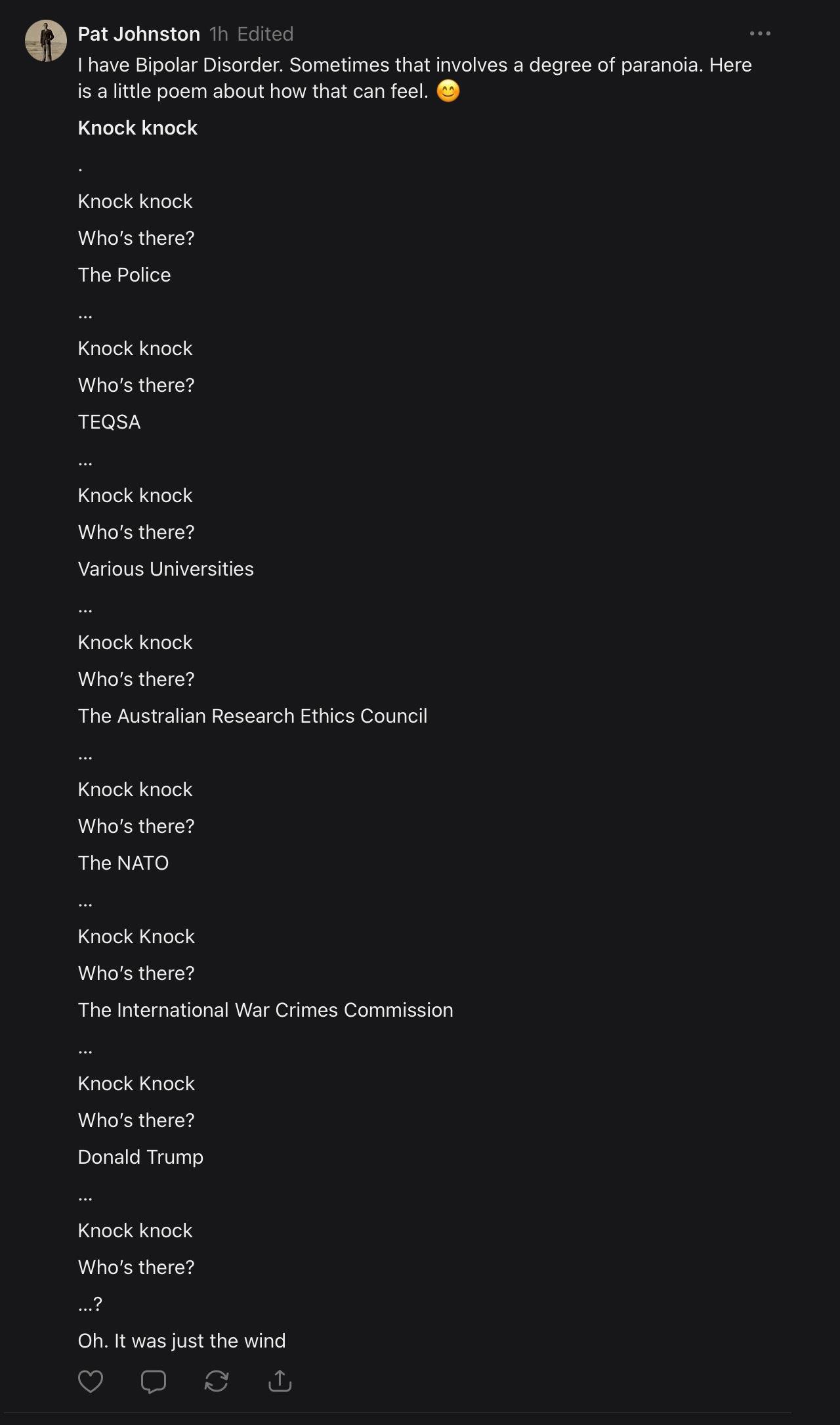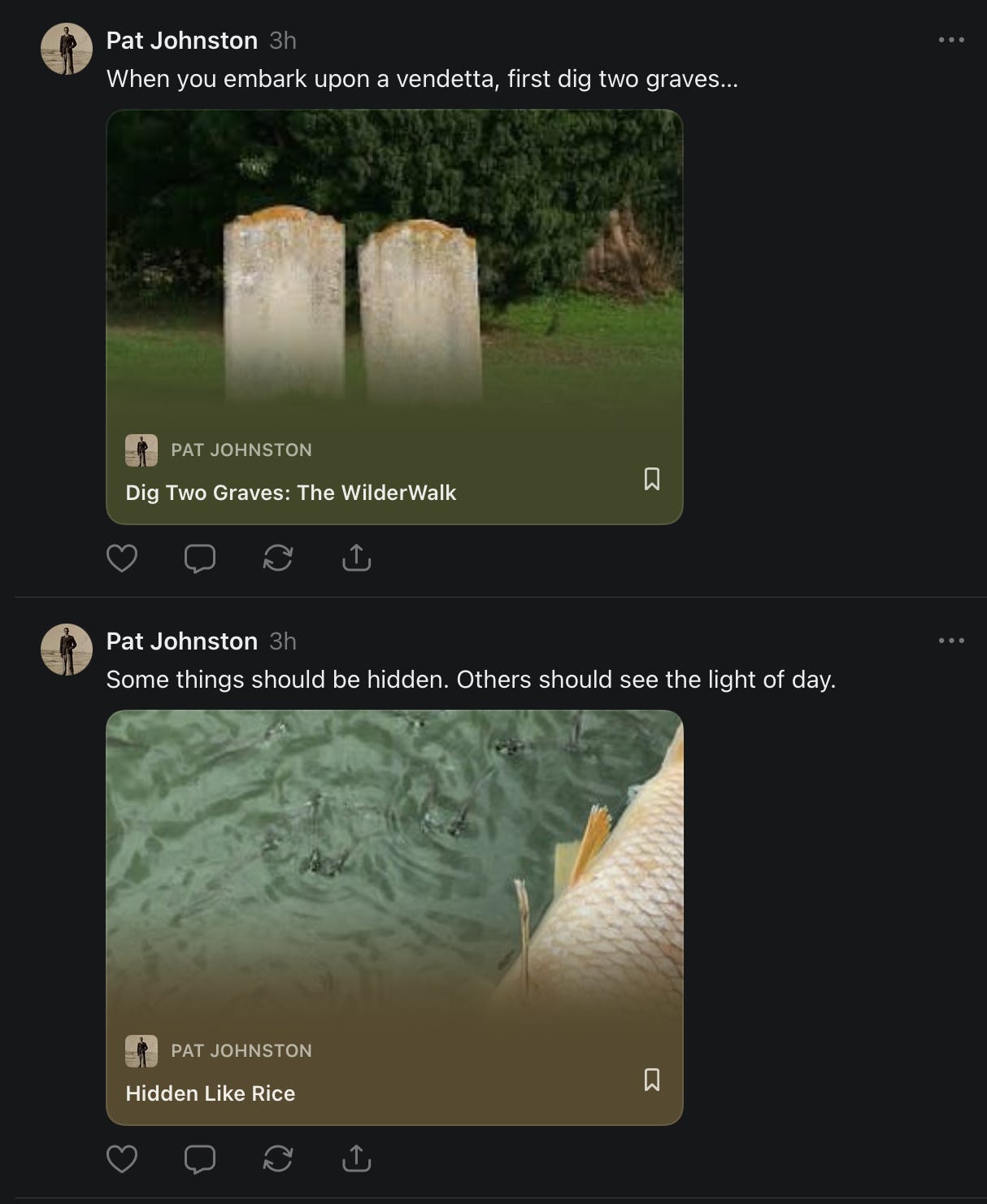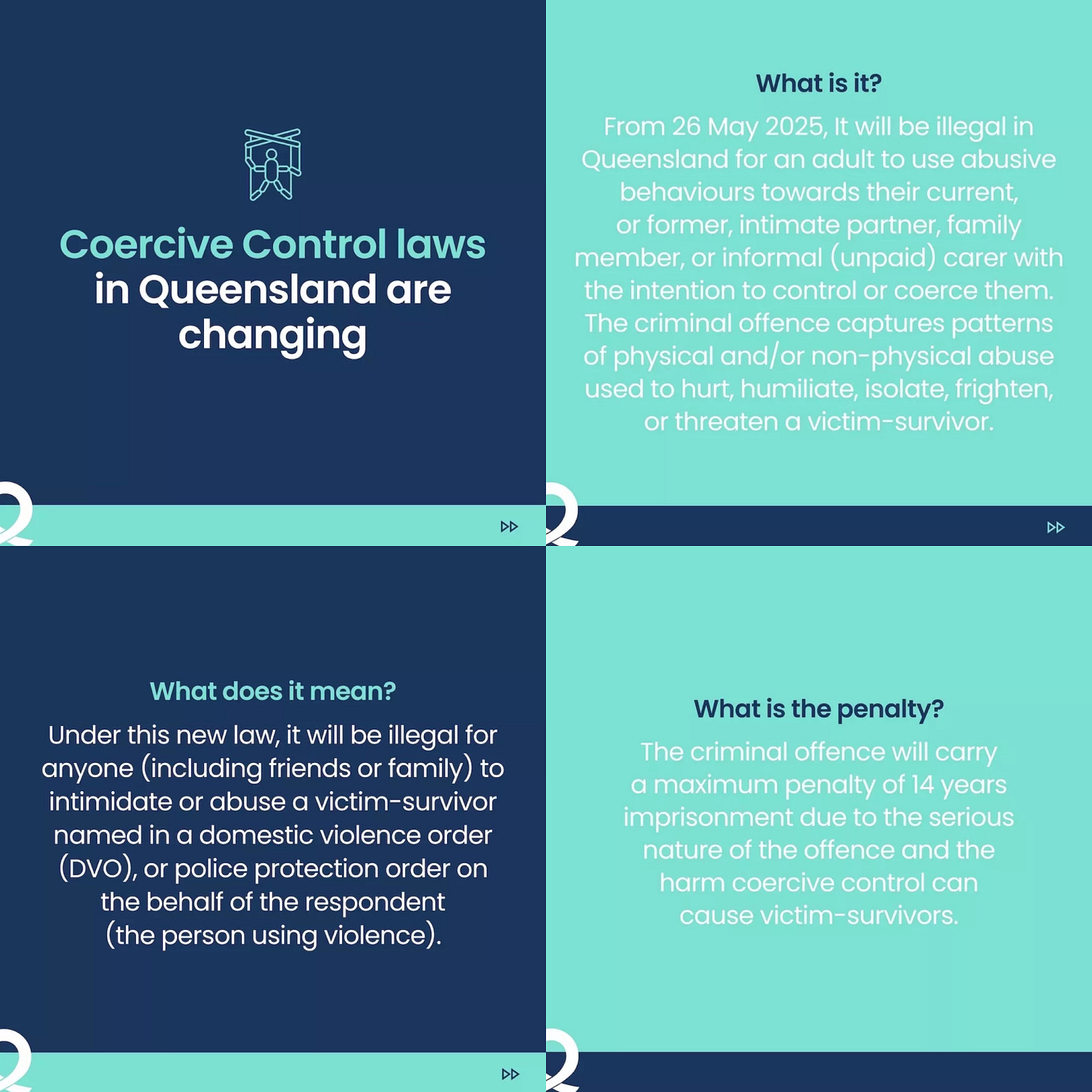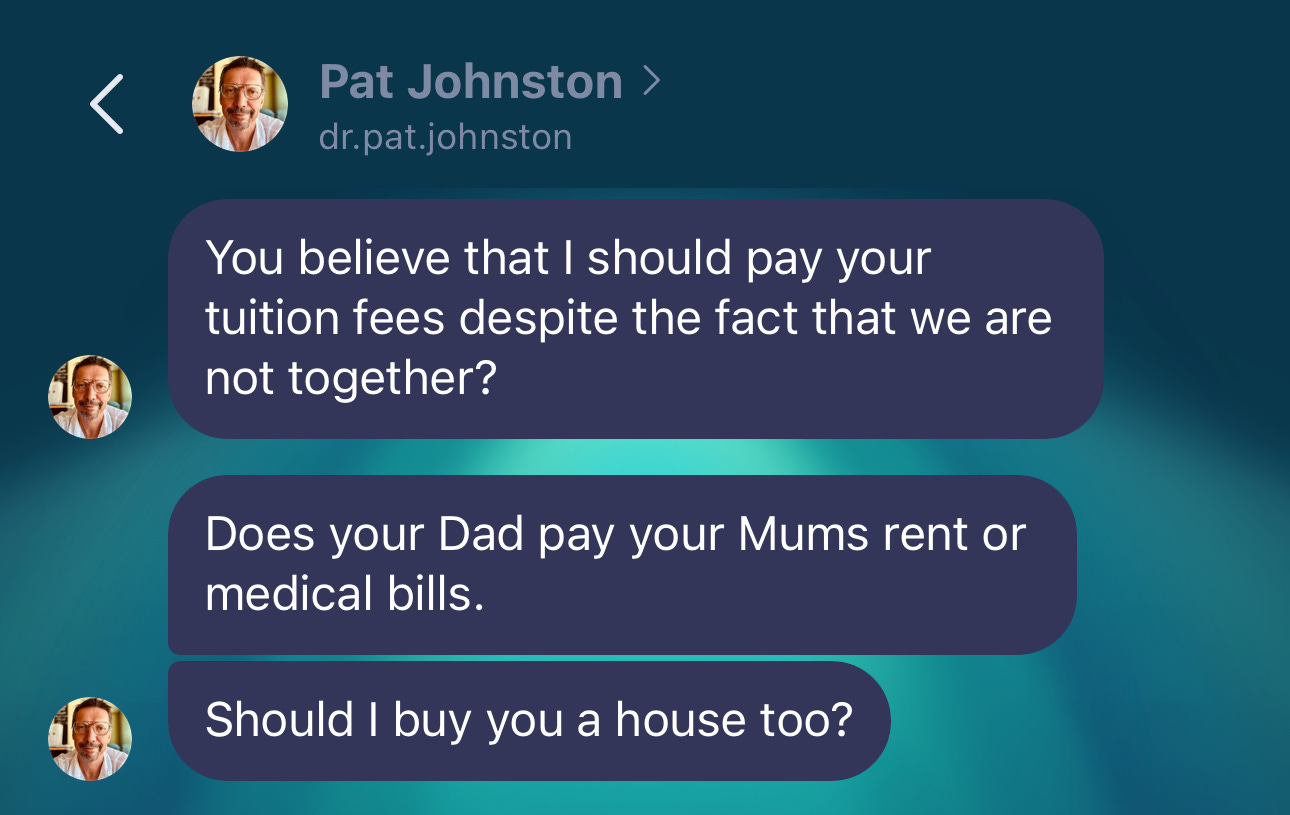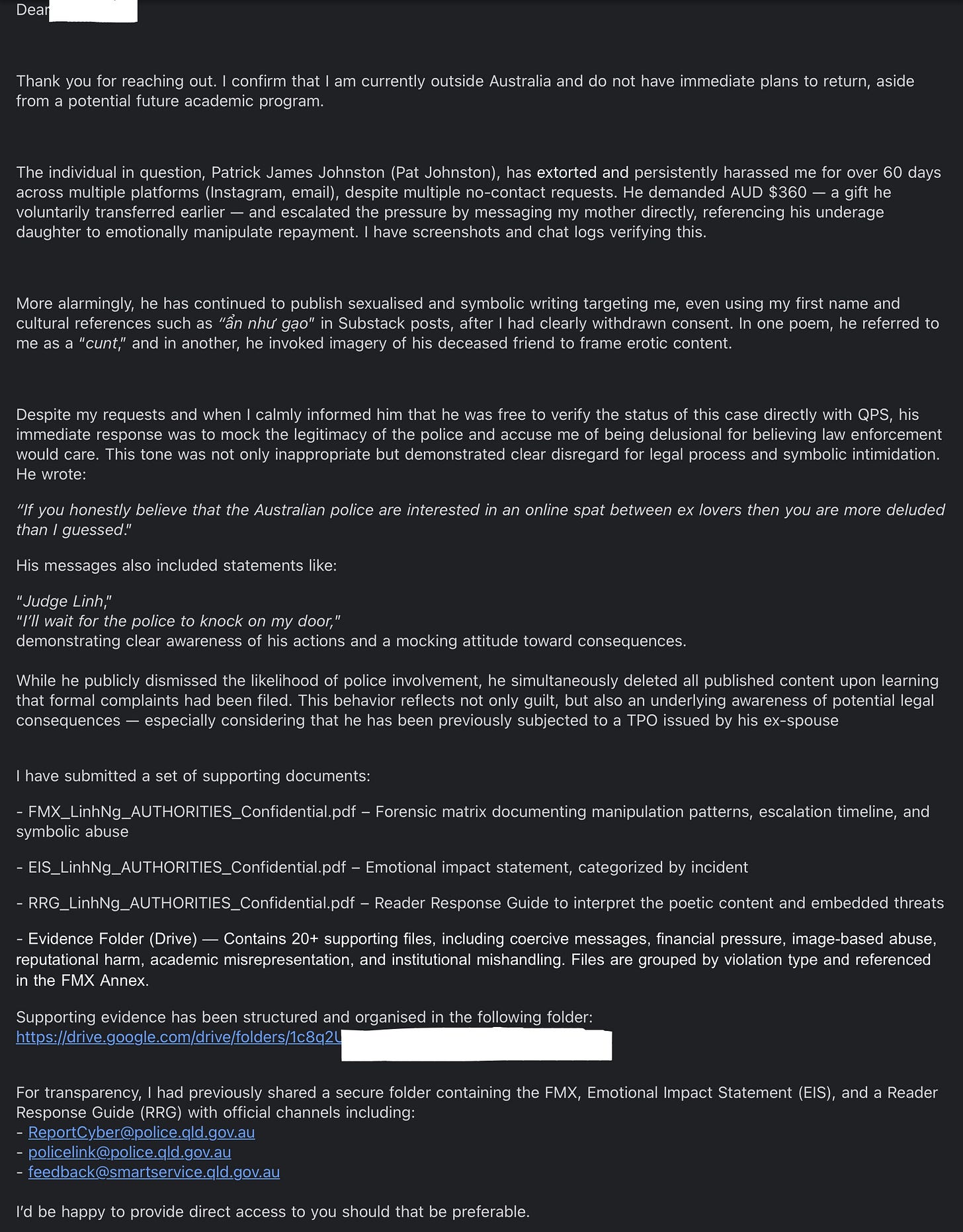Mr. J, a Former Professor Series – Entry 14: Why Sarcasm Toward Institutions Can Backfire
How Mocking Institutions Exposes You Instead
In June 2024, a Queensland court issued a Temporary Protection Order against Patrick James Johnston, valid until June 2025.
There was another woman once had to seek a Protection Order to feel safe from him.
He was previously the subject of a domestic violence protection order, filed by a former partner.
This is not the first time.
Imagine publishing a poem that mentions NATO, racial tropes, and disjointed metaphors — because a woman you dated reported you to the police. Now imagine doing that… publicly… and thinking that’s a power move.
After enduring over 70 days of cross-jurisdiction harassment by a former academic, I formally reported the matter to Queensland Police, where a Detective Sergeant of the Criminal Investigation Branch concluded I had committed no wrongdoing. This experience sharpened my commitment to ethical justice and trauma-informed research, and that no legal action would be taken against me and my public documentation series.
This was not just a relief — it was confirmation that victims who document and speak out can still stand on solid legal ground.
This excerpt is quoted from official correspondence received from Queensland Police Service. Officer name and personal identifiers have been redacted to protect privacy. The quote is presented as-is, without modification, for the purpose of public interest commentary and survivor documentation.
Email received: Jun 3, 2025
In governance contexts, the act of publicly mocking regulatory or oversight bodies — especially while under investigation — is not interpreted as wit, but as a sign of poor professional judgment and escalating reputational risk.
Such misuse of public platforms to parody regulatory bodies is unlikely to win institutional favor. As documented in my correspondence with QPS, even the police noted: ‘This report should never have been taken.’ Replacing evidence with poetry does not protect one’s record — it stains it.
Performative vulnerability used to preempt consequence - Public Note published by Pat Johnston (captured June 5, 2025; archived prior to deletion)
The original post is publicly available here at the time of writing. A full archive with timestamps has been retained for evidentiary purposes.
This reference is provided for institutional verification. In case of removal, metadata and screenshot archives are available upon request.
Full 77-harassment-day evidence archive submitted to QPS, TEQSA, AHRC and Ethics Australia: View here.
In a poem recently published online, the individual appeared to mock international institutions and survivors’ complaints — invoking NATO, Trump, and poetic metaphors. No evidence, no logic — just noise dressed as literary rebellion.
When a subject of multiple complaints responds not with substantive rebuttal, but with sarcastic poetry — especially poetry that references institutions such as the police, ethics bodies, or even geopolitical entities — they may believe they are reclaiming narrative control.
But in reality, this tactic often backfires.
When Satire Becomes Self-Report
Publishing a poem that references NATO, TEQSA, the Police, and even Donald Trump — all because a woman you dated filed a formal complaint against you, doing that publicly… and thinking that’s a smart move…
After enduring 70+ days of sustained harassment across jurisdictions, I submitted formal complaints to multiple agencies, including Queensland Police, a Detective Sergeant from the Criminal Investigation Branch reviewed the allegations and clearly affirmed:
“You have not committed any offence. There is no evidence of wrongdoing on your part.”
This was more than personal relief. It was legal affirmation — that public survivors who document abuse forensically are not lawbreakers, but recordkeepers.
So what did the subject do in response?
Not rebuttal. Not reflection. Not accountability. But a poem.
Instead of offering rebuttal, reflection, or accountability — he wrote a poem.
A poem ridiculing nearly every agency — TEQSA, QPS and any universities in my reports — through a cascade of “knock knock” jokes and literary sleight.
Mockery ≠ Innocence
The poem ridicules institutions involved in my case — naming TEQSA, QPS, universities, and even NATO, the International War Crimes Commission, and Donald Trump — in a string of knock-knock metaphors.
This isn’t literary wit. It’s symbolic deflection: a mix of paranoia, self-pity, and denial, wrapped in performative creativity.
Why This Fails — Publicly and Institutionally
1. Self-Incrimination by Satire
His poem echoes nearly every agency named in my formal complaints — inadvertently confirming he read them, and understands the gravity, even while mocking it.
When someone accused of misconduct publishes a sarcastic poem about the very bodies investigating them, they are not resisting narrative control.
They are signaling institutional awareness — and performing defensiveness in plain sight.
In professional and legal contexts, sarcasm doesn’t signal depth — it signals avoidance. When someone mocks the very institutions named in formal complaints — the police, ethics regulators, even immigration bodies — it does not suggest innocence. It suggests fear cloaked in performance.
2. Emotional Evasion Disguised as Humor
Public trust — whether in academic, legal, or ethical contexts — is built on reasoned engagement and transparent correction, not dramatized evasion.
When an individual targets institutions with mockery instead of evidence, they signal not resistance but unwillingness to be accountable. This not only shifts institutional sympathy away from them, but may trigger internal notations about reputational risk or manipulation tactics.
He writes:
“I have Bipolar Disorder… sometimes that involves a degree of paranoia…”
“Knock knock. Who’s there? The Police… TEQSA… The Wind.”
Opening with “I have bipolar disorder” and ending with “It was just the wind” doesn’t generate empathy. It trivializes both mental health and the harm caused.
This reads not as satire, but as self-justification wrapped in literary theater.
No twist. No reversal. No insight.
Just fear, reframed as farce — and illness, used as an umbrella for avoidance.
In professional ethics, this is not vulnerability. It is narrative hijacking.
Worse — it may appear as an attempt to weaponize vulnerability to preempt accountability. This is not trauma-informed — it’s performative deflection.
3. Misreading the Public Arena
When a survivor builds a forensic case, grounded in timestamps, screenshots, and formal agency response —
And the accused responds with poetic allusions to NATO and the War Crimes Commission —
That’s not a debate. That’s a mismatch of ethical registers.
In governance and public ethics, satire aimed at regulatory bodies is not interpreted as clever.
It is seen as uncooperative, strategically defensive, and professionally foolish.
Public Note published by Pat Johnston (captured June 7, 2025; archived prior to deletion)
The original post is publicly available here at the time of writing. A full archive with timestamps has been retained for evidentiary purposes.
This reference is provided for institutional verification. In case of removal, metadata and screenshot archives are available upon request.
Full 77-harassment-day evidence archive submitted to QPS, TEQSA, AHRC and Ethics Australia: View here.
When I pointed out that he continued writing poetry despite my clear “no contact” request — he affirmed it — not with words, but with actions.
You call out a boundary violation — he violates it again.
My mention of his disregard for “no contact” led to another unsolicited poem.
My comment on how he exploits his mental health narrative — he posted exactly the kind of poem that proved it.
He read my post. He saw the word “no contact.”
He understood the meaning. And he replied — not with a message, not with remorse — but with the exact and another poems.
The poem that echoed the very behaviors I had described:
romanticized violation
unsolicited narration
the use of mental health as poetic justification
references to my neurotype, family, and city — again.
In behavioral psychology and legal analysis, this tactic is known as:
narrative domination – imposing one’s version of the story even after being asked to stop
DARVO mimicry – flipping roles while ignoring responsibility
defiance through repetition – where art is weaponized, not to express, but to invalidate lived experience.
Let’s call it what it is:
“I know what you accused me of. I’m doing it again — because I believe you can’t stop me.”
That’s not a rebuttal. That’s self-verification. He isn’t denying the claims. He’s reenacting them.
What I feared most wasn’t what he did to me. It’s what he might repeat, if no one said anything.
Reference: New Coercive Control Laws in Queensland (effective 26 May 2025).
This update criminalizes sustained psychological abuse, manipulation, and intimidation — including non-physical patterns used to isolate, threaten, or harm a victim-survivor.
Maximum penalty: 14 years’ imprisonment.
Image source: DVConnect (@dvconnectqld) — used under Fair Dealing for the purpose of commentary, education, and public interest analysis.
The Psychology of Post-Complaint Mockery
Some patterns are all too familiar to regulatory readers:
Symbolic deflection: Using metaphor to dodge substance.
Performative vulnerability: Declaring pain to pre-empt criticism.
Reputation preservation through satire: Hoping mockery distracts from misconduct.
But institutions aren’t fooled.
In governance, satire that targets oversight bodies is not interpreted as clever.
It is interpreted as uncooperative, disingenuous, and strategically manipulative.
Even Queensland Police advised this individual to cease contact — and suggested pursuing civil action if he insisted. Their response included:
“This report should never have been taken.”
Which means: not only were his allegations unfounded — they were borderline vexatious.
No poetry can undo that.
Poetry is not an excuse. Your trauma doesn’t erase your actions. And invoking illness to deflect accountability — especially when you used poetry to hurt someone — is not healing. It’s manipulation wrapped in verse.
Behavioral Indicators of Escalation and Loss of Narrative Control
The subject’s recent pattern of literary publication — particularly the use of theatrical metaphors, global institutions (e.g., NATO, ICC), and veiled threats — reflects classic indicators of psychological escalation under perceived reputational threat.
Rather than engaging with the substance of the formal complaints made against him, the subject has opted to dramatize his position through poetic projection, indirect blame, and exaggerated external references. This type of symbolic overreach is consistent with established forensic models of narrative control loss, where the individual — faced with increasing documentation and public scrutiny — attempts to reframe themselves as a misunderstood or persecuted figure.
Moreover, the spontaneous invocation of institutions such as the ARC — which had not been named in any prior complaint — suggests anticipatory anxiety and internal preoccupation with potential oversight bodies. This tendency to “name before being named” is well-documented in perpetrator psychology as a leakage pattern: revealing what the subject fears before any direct accusation or escalation occurs.
Combined with repeated references to conflict, surveillance, and martyrdom, the subject’s behavior aligns with textbook patterns of defensive narrative inversion. These are not signs of philosophical detachment. They are tactical — albeit transparent — efforts to dilute accountability, regain attention, and destabilize the framing power of those documenting their behavior.
Public Consequence, Even Without Legal Charges
Using poetic platforms to:
reference institutions you’re being investigated by,
mock the survivor who reported you,
and blend illness, satire, and indirect racial commentary
is not resistance — it’s reputational self-harm.
He once apologized in private. That’s all I needed to prove this isn’t fiction.
I never asked for an apology. But he offered one — because even he knew I wasn’t wrong.
Received: April 30, 2025 - Day 55 of documented harassment
Received: April 30, 2025 - Day 55 of documented harassment
When a man bundles together money, sex, tuition, and family into one emotional ledger,
what he reveals is not love — but a belief that women inherently owe him something for what they’ve received.
His so-called apology was never a reckoning.
It wasn’t remorse — it was crisis control: “I’ve been exposed. How do I escape?”
Men like him don’t regret wrongdoing. They regret being caught.
He didn’t acknowledge harm. He retaliated.
When confronted, he shifted the blame and escalated — even dragging my parents into his attacks.
This pivot from self-defense to humiliation is a classic indicator of someone incapable of introspection.
And for the next woman, the pattern will repeat.
When conflict arises, he will weaponize the same narrative of “I was used” to excuse his abuse.
That victim complex isn’t circumstantial.
It’s structural — deeply wired — and unless dismantled through real accountability and therapy, it stays.
Johnston claims I’m “deluded” to believe police would care — ironically, after a crime report was already issued and transferred to Ferny Grove Police Station.
The respondent explicitly stated: ‘I really can’t wait for someone to come knocking on my door’ —
demonstrating awareness of potential consequences and continued escalation.
Received: May 1, 2025 - Day 56 of documented harassment
Excerpt from formal correspondence sent to Queensland Police (May 6, 2025)
Structured documentation submitted with full forensic matrix, emotional impact log, and evidence folders.
(Personal identifiers redacted for privacy and file access restricted to official authorities)
Conclusion: Spotlight ≠ Safety
When someone threatens to escalate to criminal or immigration complaints as a way to silence, coerce, or retaliate a whistleblower — it may fall under:
Coercive control: when legal intimidation becomes a form of domination.
Vexatious threat: baseless accusations used as emotional or reputational retaliation.
Abuse of process: the weaponisation of legal systems to avoid accountability.
Literary retaliation may feel powerful in the moment.
But when it blends sarcasm, delusion, and public grievance — especially while ignoring the actual evidence —
It does not protect one’s name. It stains it.
Those unfamiliar with the racialized dynamics of symbolic intrusion may see it as art. But others may recognize a colonial echo beneath the verse.
When a former academic continues to write about a younger Asian woman after being asked to cease contact — in metaphors, in grief, in silence — the result is no longer literary. It is symbolic trespass, shaped by race, gender, and power.
This isn’t simply poetic. It’s racialized — and strategically ritualized.
And when someone invokes a parent’s illness as a shield against accountability, it raises serious ethical concerns.
To suggest that a mother’s medical condition somehow explains, justifies, or softens the impact of documented harmful behavior — is misplaced at best, and manipulative at worst.
Public Note published by Pat Johnston (captured June 7, 2025; archived prior to deletion)
Grief is not a shield. And your mother’s illness is not your alibi.
If this poem was truly about your mother — and entirely separate from the pattern of symbolic harassment — then I would have no reason to respond.
But given the timing, and your documented history of embedding personal allusions into public poetry after being asked to cease contact, it’s not irrational to read even your silence — or your grief — as performative when you’ve used those emotions before to bypass accountability.
Suffering borrowed from your mother does not redeem harm you chose to inflict.
If you genuinely want to write in peace, then do it — without orbiting back into my timeline, my city, or the language of control. You lost that right the moment you used poetry to disguise harm.
Personal grief does not excuse public misconduct.
And using a parent’s illness as narrative cover can cross a dangerous ethical line — especially when the person has already been asked to stop.
In fact, if the illness is real, it deserves dignity, not weaponisation.
To reduce a mother’s suffering into an emotional buffer against the consequences of one’s own actions is not only disrespectful to others — but also to the parent herself.
Guilt cannot be outsourced to tragedy. And dignity cannot be borrowed from someone else’s illness.
This isn’t a poem about illness.
It’s a post-failure performance — one that confirms more than it conceals.
“When abusers write verse instead of owning harm, it’s not expression. It’s evasion.”
“Visibility is not victory when the spotlight reveals only incoherence.”
Toward Legislative Awareness
The broader concern isn’t limited to one individual’s misconduct — it’s the absence of systemic safeguards when literary tactics are used to bypass consent, and when symbolic coercion slips past institutional radar. If repeated patterns of narrative abuse, post-report retaliation, and reputational evasion continue to go unaddressed, then the ethical gap is no longer private — it’s legislative.
Whether or not such gaps will reach Parliament is yet to be seen. But if public documentation like this can illuminate the cost of institutional silence, perhaps it deserves to be read not only by readers — but by representatives.
Image source: DVConnect (@dvconnectqld) — used under Fair Dealing for the purpose of commentary, education, and public interest analysis.
Update (June 10, 2025): Counter-Takedown Filed — Fair Use & Survivor-Led Documentation
On June 9, I received a formal DMCA notice from Google informing me that Patrick Johnston had submitted a copyright takedown request targeting my publicly accessible survivor evidence folders documentation already submitted to QPS as part of police evidence.
This content, previously submitted to law enforcement in the context of unwanted contact and coercive behavior, cannot retroactively be reframed as protected intellectual property for the purpose of silencing survivor documentation.
Any takedown request targeting such material constitutes a strategic misuse of copyright law, not a legitimate rights claim.
These files were published strictly under academic Fair Use and Fair Dealing protections, as part of an ethics-based documentation series. This takedown is not a valid copyright dispute, but a coercive response to institutional criticism.
Attempts to assert copyright over police-submitted evidence constitute a serious ethical and potentially legal breach. Such actions may be interpreted as obstruction of justice and retaliation against protected reporting
This is not copyright protection. This is reputational panic, disguised as a takedown notice.
The content was non-commercial, already submitted to Queensland Police (QPS) and regulators under official case IDs. Its removal constitutes an attempt to suppress documented harms rather than enforce legitimate rights. Misusing copyright mechanisms in this manner may qualify as a form of strategic litigation against public participation (SLAPP).
My publication falls squarely within the thresholds of:
Australian Copyright Act 1968 – Sections 41 & 42 (Fair Dealing)
U.S. Copyright Law – §107 (Fair Use)
International norms protecting public interest commentary and trauma documentation.
I have submitted a formal counter-notice. As per standard procedure, Google has forwarded the takedown request to the Lumen Database, where it is now publicly visible as part of platform transparency archives.
View takedown request on Lumen
If harassment persists, I reserve the right to escalate this matter to ethics boards, international legal monitors, and public interest watchdogs tracking strategic censorship and retaliatory misuse of institutional tools.
Any misuse of personal information obtained via counter-notice or takedown responses will be treated as further coercive harassment and may be reported to law enforcement under digital harm and privacy abuse frameworks.
No individual has the right to suppress survivor-led documentation solely on the basis of personal discomfort — especially when such material pertains to evidence already submitted to law enforcement.
Note on Naming:
The individual named in this piece is referenced due to the public nature and severity of their documented behavior, including threats and retaliatory writings.
The purpose of naming is not humiliation, but record integrity. When public responses fail to address the core evidence presented, transparency remains necessary.
Naming in this context reflects a duty to document — not to defame. Selective rebuttal does not equate to accountability.
Full evidence archive submitted to QPS, TEQSA, AHRC and Ethics Australia: View here.
Read the full series
- Entry 1: The Man Who Taught Me Ethics by Failing All of Them
- Entry 2: The Disappearance of the Public Poet
- Entry 3: The Hanging Tree Case Study
- Entry 4: Hidden Like Accountability
- Entry 5: The Collapse of Assumptions
- Entry 6: The Ethics of a Tinder Bio
- Entry 7: How He Ate Told Me Everything
- Entry 8: What Makes a Scholar Dangerous
- Entry 9: Fragment of Life, Fragment of Accountability
- Entry 10: Anatomy of Disappointment
- Entry 11: Legal Defense Challenges: A Framing Statement
- Entry 12: Six Years After Ronell – What Academia Still Doesn’t Get
- Entry 13: QUT and The Man Who Raped Me
- Entry 14: Why Sarcasm Toward Institutions Can Backfire (you are here)
- Entry 15: P*ssy or Toxic Masculinity?
- Entry 16: Who is Your Favorite Comedian?
- Entry 17: And What is Your Favorite Song?
- Entry 18: Grant Proposal — Narrative Ethics as Survivor-Led Forensics
- Entry 19: The Coward Behind the Clone
- Entry 20: [URGENT HIRE] CRISIS COMMUNICATIONS SPECIALIST
- Entry 21: [URGENT] Legal Counsel Needed for Complex Reputation Rehabilitation
- Entry 22: YOU’RE AN ABUSER. STOP CONTACTING ME
- Entry 23: Seeking Counsel for a Fallen Academic
- Entry 24: Internal Legal-PR Briefing
- Entry 25: For Journalists – Legal & Ethical Clearance Summary
- Entry 26: Symbolic Prostitution, Transactional Intimacy, or Just a “Loan”?
- Entry 28: Why He Simply Cannot Shut Up
- Entry 29: Forensic Commentary on “LARGE Language Muddle”
- Entry 30: Don’t Just Threaten My Future. Because I’m Going To Archive Your Present
- Entry 31: Open Letter to the Person Who Tried to Break Me with Defamation
- Entry 32: Defamation, Harassment, Doxxing Class 101
- Entry 33: Confidential Crisis Recovery Proposal
- Entry 34: Forensic Behavioral-Somatic Report
- Entry 35: Forensic Commentary on the Tattoos
- Entry 36: QUT and the Abuser They Once Had
- Entry 38: When Poetry Becomes Revenge Porn
- Entry 40: A Man Built for Applause, Not Accountability
- Entry 41: Neurobehavioral Addendum
- Entry 43: Why Does It Sound Like a War Metaphor?
- Entry 44: Forensic Commentary on Racialized and Fetishizing Language in “Hidden Like Rice”
- Entry 45: Public Misuse of Former Academic Affiliation
- Entry 46: The Two Things That Didn’t Leave a Bad Impression
- Entry 47: When Affection is Just an Alibi (A Bundy-Inspired Reflection)
- Entry 48: Humbert, Lolita, and the Fetish of Fragility
- Entry 49: The Fetish of Smallness as Symbolic Violence
- Entry 50: Motif Risk Analysis
- Entry 52: Can an Abuser Be a Good Father?
- Entry 53: Who Protects the Children?
- Entry 54: From Blackmail to Children
- Reflection: The Miscalculation
(More entries coming soon)
→ [Back to Start: Introducing Mr. J, a Former Professor Series]
© 2025 Linh Ng. All rights reserved.
This publication is intended for educational and reflective purposes only.
Sharing the original link is welcomed and encouraged.
Please do not reproduce, redistribute, or translate this content — in whole or in part — without written permission.
This piece reflects both lived experience and critical analysis. It is not meant to be detached from its author or reframed without context.
Misuse or decontextualization may lead to formal clarification or takedown requests.
This work has been reviewed and quietly followed by scholars, educators, and ethics professionals across multiple sectors.
If your institution is engaging in critical discourse around narrative justice, symbolic coercion, or representational ethics, feel free to connect via Substack DMs or formal channels.
A regulatory case regarding this matter has already been classified under a protected status within national education integrity systems.
Should any reputational countermeasures or distortions arise, I reserve the right to publish the documented timeline, behavioral patterns, and contextual metadata.
All relevant documentation has been submitted through formal legal and regulatory pathways.
Photo cover by Siarhei Horbech on Unsplash





